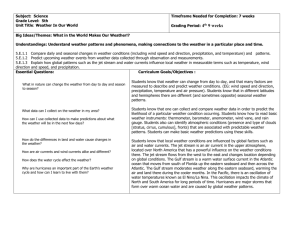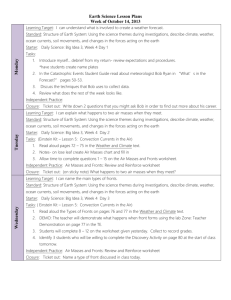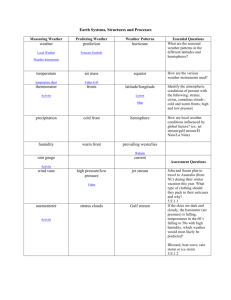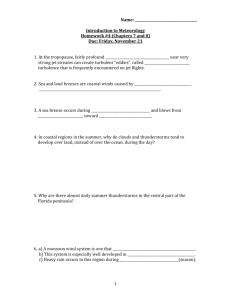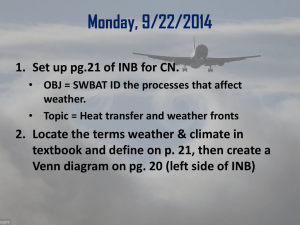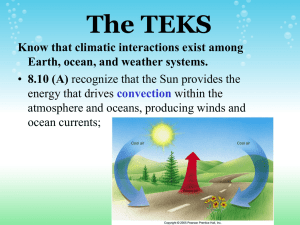ppt
advertisement
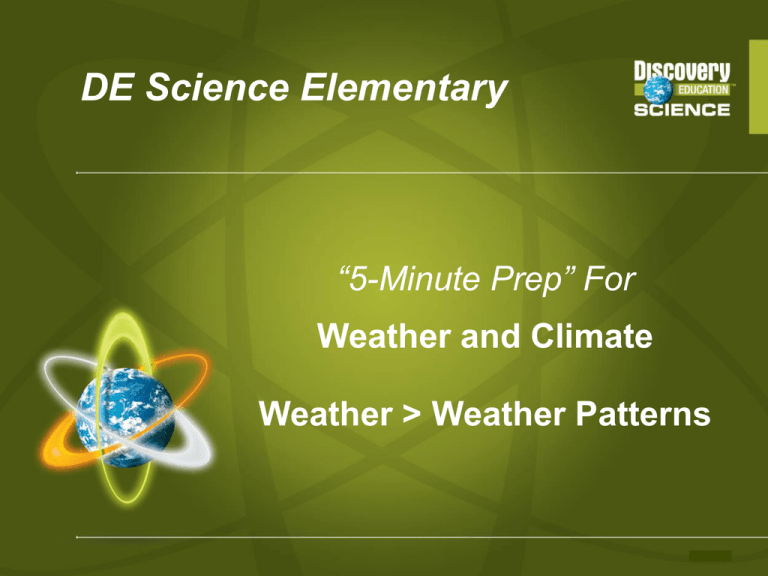
DE Science Elementary “5-Minute Prep” For Weather and Climate Weather > Weather Patterns Weather Patterns – The Big Ideas • • • • • Air masses are broad areas of air with the same temperature and humidity. Air masses with different characteristics meet at a front, or a boundary. Weather maps show the locations of fronts, temperatures, wind speeds and direction, precipitation, and air pressure. Different kinds of weather are associated with warm, cold, stationary, and occluded fronts. The jet stream, the Gulf Stream, and other large air and ocean currents influence global weather patterns. Weather Patterns – Prior Knowledge Students have probably learned about weather in their early elementary years. They are probably familiar with sky conditions and temperature, but will not have much background knowledge on cold fronts, air masses, and ocean currents. It would be helpful for students to view the FUN-damental Under the Weather to review the basics about weather and how its reported. It would also help if students: – Have viewed weather reports in newspapers or television. – Have seen a weather map with weather symbols that indicate cold or warm fronts. Weather Patterns – Common Misconceptions • The jet stream is a place where airplanes fly in the sky. – Reality: Jet streams are fast flowing, relatively narrow air currents. They form near boundaries of adjacent air masses with significant differences in temperature. Meteorologists use the location of the jet stream to aid them in forecasting. During airline travel, flying long distances along with the jet stream can cut hours off a long distance trip. • The H on weather maps stands for hot temperatures whereas L means cold weather . – Reality: Symbols on weather maps are misleading to many people. The H and L represent areas of high and low pressure. • Isobars on weather maps represent wind speed or temperature . – Reality: The isobars represent areas of equal pressure. Weather Patterns – Using DE Science Content When you close this presentation, you can review the following recommended resources for Weather Patterns. • • • • Virtual Lab: What Shall We Do Tomorrow? Exploration: Weather Patterns Video: Ocean Currents E Book: The Schoolhouse Blizzard Use the PowerPoint version of this presentation for hyperlinks to these resources or you can get to them through the browser or search feature. Weather Patterns – Instructional Ideas • In the Exploration, students will learn about warm fronts, cold fronts, and stationary fronts and how they are formed as they match labels with pictures of each of these. – Next students examine a weather map and determine which direction the weather patterns are traveling. – Show students a copy of the weather maps from your local paper over a five day period and ask them to explore how the weather moves across the country. Weather Patterns- Instructional Ideas • Before showing the video called Ocean Currents, provide students with a list of statements about ocean currents and ask them to identify them as being true or false. – This is called an anticipation guide. It will help students focus on what is important as they watch the video. – After watching, students can confirm or fix their initial responses. Also, after the video is over, ask students to dialogue with a partner about how oceans and currents affect climate. • After students read the E Book called The Schoolhouse Blizzard, give students a blank map of the United States. – Students can create weather conditions all over the country using correct weather symbols. – Students can then switch maps with a partner and report the weather in certain areas of the country. State standards: If you wish to review your state standards regarding Weather Patterns, click here to get to the curriculum standards search feature of DES. http://discoveryeducation.com/forward/curriculum.cfm You can click on any standard to see what resources are available to teach it. Additional Information: For additional content, check the Extend section within the concept.


